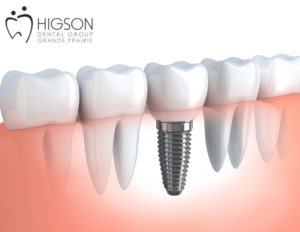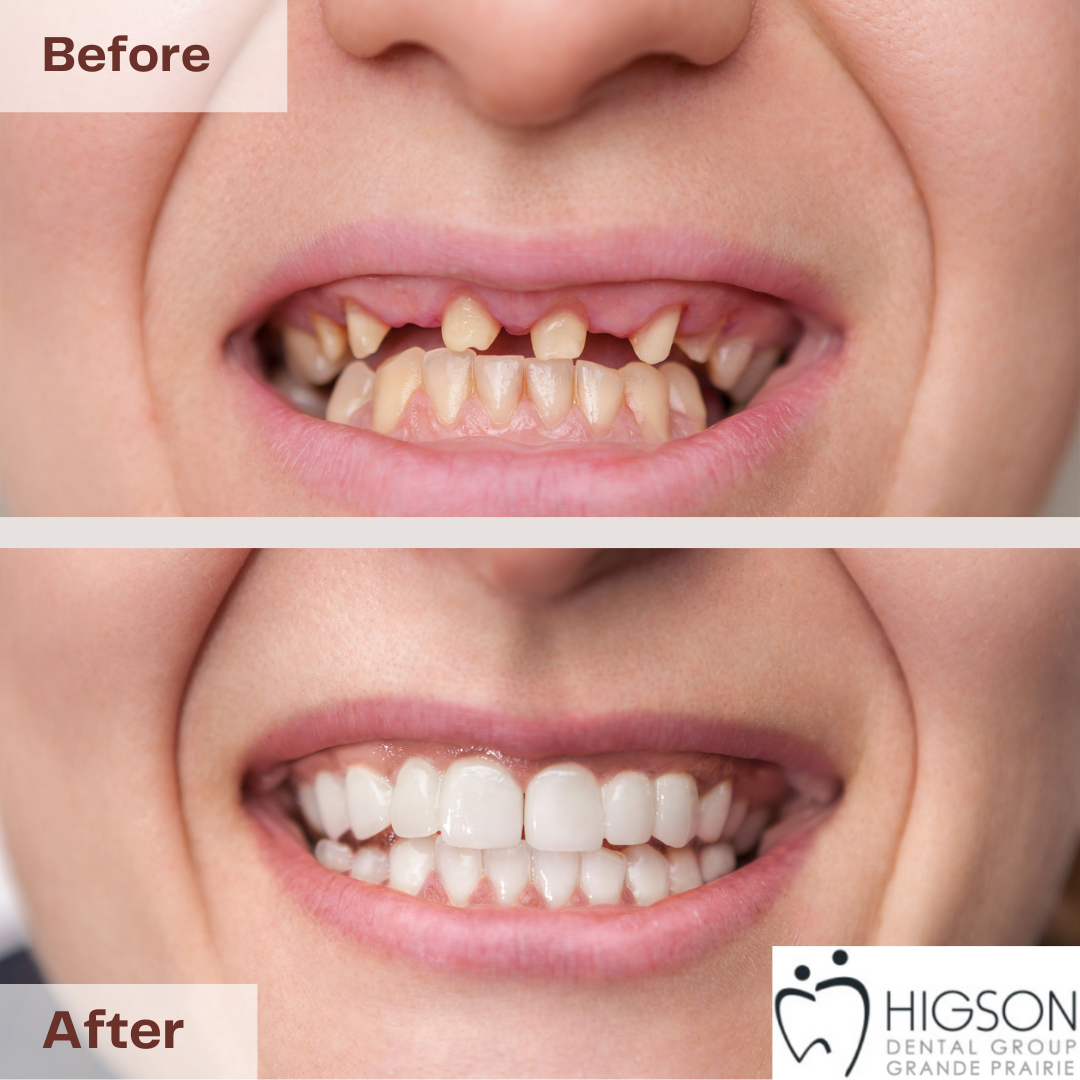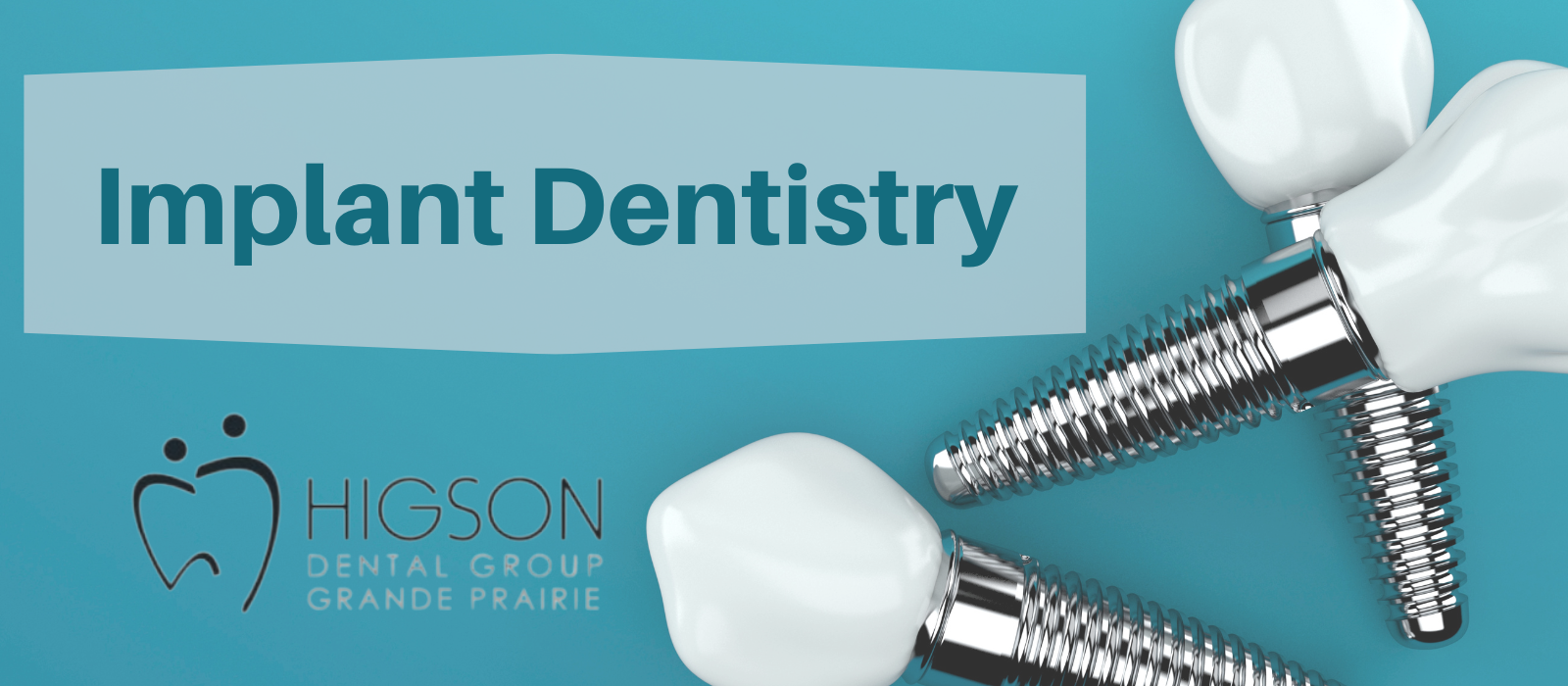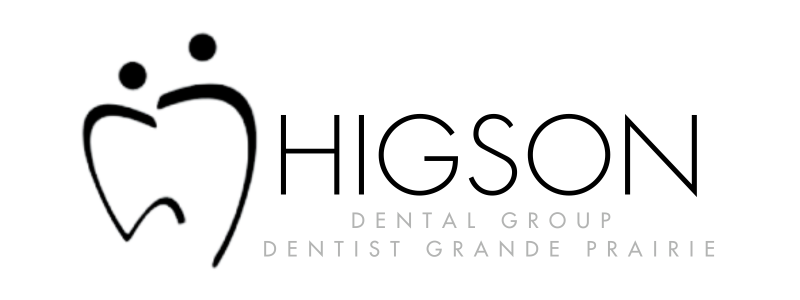Best Dental Implants in Grande Prairie, AB
No matter how dedicated you are to oral health, life happens, and for any number of reasons, you may find yourself with a failing or missing tooth. Gaps between your teeth are not only unsightly but also detrimental to the overall health of your mouth. Luckily, Higson Dental Group’s cosmetic dentists have excellent options for dental implants near you in Grande Prairie, Alberta.

Dental implants are one of the most reliable and long-lasting solutions for replacing missing teeth. They offer the look, feel, and function of natural teeth, restoring your smile and boosting your confidence. However, achieving a successful implant outcome isn’t about rushing through the process; it’s about taking the necessary time to ensure everything is done correctly. The All-on-4 dental implants cost is an important consideration, but it offers a full set of teeth with fewer implants, making it a popular and cost-effective choice.
On This Page
ToggleContact Us »
Benefits of Implant Dentistry
As a permanent, non-removable replacement for lost teeth, dental implants are the next best thing to your natural tooth. They help support the jaw and prevent bone loss that can happen around your missing tooth. Since dental implants are surgically inserted into your mouth and heal into the jaw, they become a part of your mouth and can last for many years. Sometimes receiving a dental implant is an important step before fitting for new dentures.
How Do Dental Implants Work?
The dental implant process is meticulous, and every step is crucial to achieving a successful outcome. Here’s an overview of what to expect:
- Initial Consultation and Assessment: The initial step involves a detailed evaluation, including a review of your medical and dental history, digital X-rays, and sometimes a CBCT scan, to assess your candidacy for dental implants by examining your gum health and jawbone density to ensure sufficient support for the implant.
- Tooth Extraction (if Necessary): If the damaged or decayed tooth hasn’t already been removed, the first step may involve extracting it. We ensure that the extraction site heals properly before moving on to the next phase.
- Bone Grafting (if Needed): In cases where the jawbone is too weak for an implant, a bone graft may be needed to enhance its strength and density, providing a stable foundation; though healing takes several months, it ensures long-term implant success.
- Placing the Dental Implant: Once your jawbone is ready, a titanium dental implant, acting as a replacement root for the missing tooth, is surgically inserted into the jawbone under local anesthesia or sedation for your comfort.
- Healing and Osseointegration: After placing the implant, we allow 3-6 months for osseointegration—where the jawbone grows around the implant to secure it—while monitoring your progress with follow-up visits to ensure proper healing.
- Attaching the Abutment: Once the implant has fully integrated, we attach an abutment, a small connector piece that will hold the crown. The gums may need an additional few weeks to heal around the abutment before the final crown is placed.
- Placing the Final Crown: The last step involves placing the custom-made crown, which is designed to match the shape, color, and size of your natural teeth. This crown is either cemented or screwed onto the abutment, completing the process and giving you a fully functional, natural-looking tooth.
Healing Time and Why We Wait Between Steps
Healing is the foundation of a successful dental implant. While it may be tempting to rush through the process, allowing adequate time for healing ensures the stability and longevity of the implant.
- Osseointegration is Key: The most important part of healing is osseointegration, where the bone fuses with the titanium implant. This process can’t be rushed, as the bone needs time to grow and firmly anchor the implant. If we skip or shorten this healing period, the risk of implant failure increases significantly.
- Bone Grafting Requires Patience: If you needed a bone graft, the healing time can be even longer. The bone graft must fully integrate and strengthen the jaw before the implant can be placed.
- Gum Healing: After the abutment is placed, the gums need time to heal and form a seal around the implant. This ensures a natural appearance and prevents infection.
By allowing sufficient time between steps, we ensure the implant has the best chance of lasting a lifetime. The entire process typically takes around six to twelve months, depending on factors such as the location of placement and your overall health. Once the implant is completed, you’ll be able to eat, speak, and smile with confidence. With proper oral hygiene and care, your implant can last a lifetime.
Immediate Placement vs. Traditional Implant Timeline
You may have heard about “immediate implants” where a tooth is extracted, and the implant is placed the same day. While this may sound convenient, it’s not always the best option. Here’s why:
- Immediate Placement: Immediate implants can be an option in cases with minimal infection and sufficient healthy bone, though they carry a higher risk of failure. When performed under ideal conditions and with expert precision, placing an implant immediately after extraction can be successful in carefully selected cases.
- Traditional Implant Timeline: In our practice, we often recommend a more traditional approach: extracting the tooth, allowing the site to heal for 3-6 months, and then placing the implant. This waiting period helps reduce the risk of complications and ensures the bone is strong and stable. Although the timeline may be longer, it offers more predictable and successful outcomes. In the long run, this approach reduces the risk of implant failure and the need for corrective procedures, ensuring a more reliable and lasting result.
What to Expect During Healing and Integration
Healing after dental implant placement is usually straightforward, but it requires some care and patience. Here’s what to expect:
- Managing Discomfort: Some swelling, bruising, and mild discomfort are normal after surgery. We’ll provide you with post-operative instructions and may prescribe pain medication to manage any discomfort.
- Dietary Restrictions: You’ll need to stick to a soft diet for a few days following surgery. Avoiding hard or crunchy foods helps the implant site heal properly.
- Follow-Up Visits: Regular check-ups are essential to monitor the healing process. We’ll ensure the implant is integrating well and address any concerns you may have.
- Oral Hygiene: Maintaining good oral hygiene is crucial. We’ll show you how to clean around the implant site to prevent infection and promote healing.
Why We Avoid Shortcuts for Long-Term Implant Success
At Higson Dental, we prioritize quality and long-term success over speed. Dental implants are a significant investment in your oral health, and we want to make sure they serve you well for many years. Here’s why taking a careful, step-by-step approach matters:
- Higher Success Rates: Studies show that a traditional, staged approach to implant placement has a higher success rate compared to immediate placement. By allowing the bone and gum tissue to heal fully, we set the stage for a stable, long-lasting implant.
- Reduced Risk of Complications: Rushing the process increases the risk of complications like implant failure, infection, and poor integration with the bone. By following a structured timeline, we minimize these risks and give your body the best chance to accept the implant.
- Better Aesthetics and Functionality: Waiting for the gums and bone to heal properly ensures a better aesthetic result. The crown will fit more naturally, and the implant will function more like a natural tooth.
Before and After Photos of Dental Implants
Implant dentistry procedures can greatly improve your smile and have fairly dramatic results. As seen in the before and after images below.

Are Dental Implants Painful?
Although it sounds like it would be very painful, having a dental implant placed is much less uncomfortable than you would think. Because of the nature of implant placement, using slow-speed drilling and copious irrigation to reduce head, postoperative pain is typically reported to be less than a tooth extraction.

Smile again with dental implants in Grande Prairie from Higson Dental Group
How Long Will a Dental Implant Last?
The longevity of a dental implant is largely determined by its owner. After the initial integration (healing) phase is successfully completed, an individual can expect many years (decades) service from an implant and its associated restoration. However, peri-implantitis (gum disease around implants) and other factors such as poor home care can greatly affect their long-term prognosis.
How Much Do Dental Implants Cost in Alberta?
In Alberta, Canada, you can expect to pay anywhere between $1500 to $3000 for a single dental implant. These ranges depend on factors like:
- Type of implantation
- The professional who performs the surgery
- Location of surgery
- Implant material
For a look at standard pricing on common dental practices, visit the Alberta Dental Guide for Dental Fees. If you’re looking to learn more about the options for All-on-4 dental implants, our team of dental professionals is here to help you explore the All-on-4 dental implants cost in Alberta.
Schedule an appointment with a dentist in Grande Prairie today to discuss dental implants near you!

All-On-4 Dental Implants
One especially innovative option is All-on-4 dental implants, which provide a full arch of teeth supported by just four strategically placed implants. This approach is ideal for those missing multiple teeth or in need of full mouth restoration. While the cost of All-on-4 dental implants can exceed $30,000, many patients find the investment worthwhile for the transformation it brings to both appearance and oral health. If you’re ready to explore this life-changing solution, consult with our dentist near you to see if All-on-4 is right for you.
How Much Does All-On-4 Dental Implants Cost?
 If you’re wondering what the cost of all-on-4 dental implants is, the price typically ranges from $20,000 to $30,000 in Canada, which includes the surgery and a custom denture. All-on-6 dental implants generally cost more due to the additional implants required. Prices can vary significantly based on factors such as necessary preparatory procedures, the type of prosthetic teeth selected, and the expertise of the dental provider. In Alberta, costs are typically in line with the national average, though specific dental clinics may have different pricing structures. Additionally, the cost of replacement dentures due to improper care or trauma can range from $10,000 to $15,000. Despite the high cost, these procedures can offer a long-lasting and natural-looking solution for those with missing teeth.
If you’re wondering what the cost of all-on-4 dental implants is, the price typically ranges from $20,000 to $30,000 in Canada, which includes the surgery and a custom denture. All-on-6 dental implants generally cost more due to the additional implants required. Prices can vary significantly based on factors such as necessary preparatory procedures, the type of prosthetic teeth selected, and the expertise of the dental provider. In Alberta, costs are typically in line with the national average, though specific dental clinics may have different pricing structures. Additionally, the cost of replacement dentures due to improper care or trauma can range from $10,000 to $15,000. Despite the high cost, these procedures can offer a long-lasting and natural-looking solution for those with missing teeth.
What is an All-On-4 Dental Implant?
All-on-4 implants are permanent and non-removable dental solutions, offering a fixed alternative to traditional dentures. Unlike dentures, they do not require removal after meals or before bed and can be cleaned and maintained just like natural teeth. Additionally, All-on-4 implants cause less irritation and inflammation compared to dentures, providing wearers with greater comfort. These implants allow individuals to properly chew all types of food without discomfort.
Typically, an All-on-4 implant system consists of 14 teeth, including 4 incisors, 2 canines, 4 premolars, and 4 molars. The implants are designed to replace all teeth in the upper or lower jaw, with the denture using these 14 teeth. The All-on-4 system is specifically intended to provide a complete replacement of teeth.
The All-on-4 dental implant technique is a revolutionary procedure that restores a patient’s smile, facial structure, and muscle tone, particularly after chronic tooth decay, bone loss, or infections. This method allows patients to regain full use of their mouth and teeth, significantly improving their ability to eat and speak. It also produces quick results, often without the need for extensive bone grafting.
All-on-4 implants are designed to be a permanent and affordable dental solution. With four implants supporting the upper and lower dental arches, this system offers unmatched strength and stability. The custom-designed prosthetic arch mimics the look and feel of natural teeth and gums.
These implants are known for their durability, with studies showing they can last 20 years or more when properly maintained. While the implant posts themselves generally do not need replacement, the dentures may experience regular wear and tear over time.
The Difference Between All-on-6 and All-on-4 Dental Implants
All-on-6 dental implants are similar to the All-on-4 procedure but involve the placement of six implants instead of four, providing additional stability and enhanced support for the jaw. Oral surgeons may recommend All-on-6 implants if a patient needs extra implants for added strength or if they are at higher risk for bone density loss. The full-mouth restoration process begins with a thorough consultation and examination, during which dental health professionals will guide the patient through every step of the procedure to restore full function and achieve a beautiful, new smile.
Both All-on-4 and All-on-6 refer to the number of implants used in the treatment. These implants are securely anchored into the jawbone, typically in configurations of two, four, or six, unlike traditional dentures, which rest only on the gum tissue and jawbone. For those considering alternatives to conventional dentures in Grande Prairie, All-on-4 and All-on-6 implants offer a more stable and long-lasting solution. The procedure for both implant options usually takes between one and two hours, with healing times ranging from three to six months.
Success Rate of All-On-4 and All-On-6 Dental Implants
The success rates for both All-on-4 and All-on-6 dental implants are quite high. All-on-6 implants have a post-operative success rate of nearly 98%, with only 2% of failures due to the jawbone rejecting the implant. Similarly, All-on-4 dental implants have a success rate of over 97%, making them an effective and long-lasting solution for many people.
Next Steps for All-on-4 and All-on-6 Dental Implants
We’re happy to provide standard pricing for common dental services, including dental implants, based on the Alberta Dental Guide for Dental Fees. If you’re interested in the cost of full mouth dental implants such as All-on-4 or All-on-6, please note that it’s challenging to offer an exact quote upfront. This is because stages 1 and 2 of treatment are performed at separate facilities, and total costs can vary significantly—often exceeding $30,000.
However, we can provide an estimate for Stage 3, which is completed at our office. The cost for the implant crown is typically around $1,600.
If you’re ready to explore the life-changing benefits of All-on-4 dental implants, our experienced dental team is here to guide you every step of the way. Contact a dentist near you today to schedule a consultation, discuss your options, and take the first step toward a confident, lasting smile.
What are Some Alternatives to Dental Implants?
Dental implants are an excellent, long-term option for those facing tooth loss. However, they may not be the right choice for everyone. There may be medical reasons why some patients cannot have dental implants or it may be patient preference. It’s important to understand your options. Dental bridges, partial dentures, implant dentures and full dentures are some alternatives to dental implants.
Dental bridges are used when more than one tooth has been lost. The bridge can be either permanent or removable, and attaches artificial teeth to the existing adjacent teeth, which are also called abutment teeth. Fixed bridges are permanently attached to the abutment teeth either with crowns or through bonding, while removable bridges use metal clasps or precision attachments to fasten to the existing teeth, and can be taken out of your mouth at any time.
Similar to dental bridges, a partial denture replaces several missing teeth. A person may need partial dentures for their front teeth, partial dentures for their back teeth, or some other combination. Partial dentures are best for people who still have some of their own teeth. They use a cast framework and molded teeth that attach to natural teeth for support. Dental implants are sometimes used to anchor partial dentures. A denture secured with dental implants helps considerably in preventing bone loss.
Implant dentures permanently attached to the jaw using several dental implants, implant secured dentures provide the highest rate of patient satisfaction and a stable solution.
Full dentures are used to replace all of a person’s upper or lower arch of teeth. Complete dentures replace a full row of top or bottom teeth. Upper dentures include gum-coloured acrylic and cover the roof of the mouth and bottom dentures curve in the shape of a horseshoe, to give space for the tongue so you can properly eat and talk.
With any kind of tooth loss, daily functions such as eating and speaking can be challenging. You can also feel self-conscious about the look of your smile when there are unnatural gaps. Replacing missing teeth with either dental implants or any of the dental implant alternatives, will help with day-to-day functionality, overall health and self-confidence. At your nearby Higson Dental, we will thoroughly assess your oral health during a comprehensive exam, discuss your personal concerns and help you choose the type of implant dentistry that is right for you.
Contact Us »
Convenient Dental Implants Grande Prairie, AB
Contact Us for Dental Implants Near You
While the dental implant process requires patience, the results are worth the wait. By taking the necessary time for healing and integration, we ensure that your implant is stable, secure, and long-lasting. Our careful, step-by-step approach prioritizes your health and sets you up for a successful outcome. If you’re considering dental implants, remember: good things come to those who wait—and we’re here to guide you every step of the way.
Find out if dental implants are the right choice for you. Our Grande Prairie, AB dental team will happily answer any questions you may have, such as cosmetic dentistry costs. Looking for a dentist near Westlake, AB? Contact us today!
Call Higson Dental Group in Grande Prairie, Alberta at 780-532-4661.
What Our Clients Have to Say About our Implant Dentistry Services in Grande Prairie:
“I definitely recommend this office! I’m their client for 10 years and would not go anywhere else! They are friendly and very professional.”
Rating: 5/5 ⭐⭐⭐⭐⭐
Kim P.
Read more of our 106 reviews on Google!
Request an Appointment
Featured Review of Higson Dental Group - Dentist Grande Prairie by Pam H. on Google
I have been going to this dental office for 15 years or more. Three generations of my family go. Believe me, they go the extra mile to dispel any fears, especially for children, take the time to listen to any concerns, are professional, friendly and above all - are very good dentists, hygienists and dental assistants working in a relaxed atmosphere. Last time I was in I was surprised I could charge my cell phone while waiting for my appointment while my grandchild played in the modern equipped play area. For anyone with time restrictions this office runs on schedule.
We're Proud of Our 5/5 Rating Across 140+ Reviews on Google
Serving the Following Alberta Communities in the Peace Country:
Grande Prairie, AB • Spirit River, AB • Valleyview AB • Beaverlodge, AB • Fairview AB • Peace River AB • Grimshaw AB • Sexsmith AB • High Prairie AB • Falher AB • Grande Cache AB
Contact Us
10508 67th Avenue, 3rd Floor
Grande Prairie, AB T8W OK8
Toll Free: 1-800-215-8253
Phone: 780-532-4661
Fax: 780-532-7059


